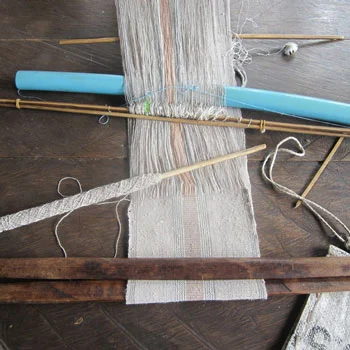Woven Together
May’s porch is always full of activity. Looking over the mountain valley village in Northern Thailand, it’s where her family cooks, plays and rests (in their very popular hammock). There are always visitors. Grandmothers sipping on instant coffee, chatting about their misadventures in cell phone use. Men taking breaks from the afternoon heat of rice fields, tightening their son’s slingshots. Women setting looms, sitting behind looms and talking about looms. Energetic children playing and laughing - doing what children do. Sometimes, the chickens try to sneak up too.
*Guest post from social activist, Jeanna Bauer.
During my short visit, every female over the age of nine who stepped foot on the porch helped me in the pursuit to weave a shirt. From head nods to say, “you’re doing it right”, wrinkled brows to say, “you’re doing it wrong”, the reconfiguring of bamboo rods and most often, getting behind the loom themselves – they all did something.
It made me mad.
Learning to Let Go
The trip stemmed from my dream to learn to weave on a back strap loom. I’m fascinated by the craft: the patterns, colors, folklore, tradition and cultural preservation. My stacks of books and market splurges are fun to look at, but I wanted my understanding to reach a deeper level. I wanted to learn. So I could weave. So I knew how it worked. So I, could say, “I did it”.
Every tap on the shoulder and non-verbal motioning to ‘de-strap’ so someone else could sit behind my loom was increasingly irritating. Couldn’t they see that I was getting the hang of it? That I was having significantly less thread emergencies than the day before? With every pound of the bamboo beater, the sound of another row completed, I felt less able to say, “I did it”.
Favorite Colors
One afternoon while sitting with a few weavers I asked questions. I asked their favorite color and they all said, “red”. I asked what they think about when they weave and they all said, “finishing”. I asked how they learned and they all said, “by observing”. Huh? I had been expecting them to say, “my mother” and share stories of the special day their mothers sat with them behind a loom passing down their knowledge of warp and weft. Their fond memories were actually of sitting with the women of their village as little girls, helping them roll thread, listening to their gossip and watching their bodies at work. None of them remembered their first time behind a loom.
There I was, taking my own observation time as an insult. I was resisting community, one of the aspects most important to the craft. It became so obvious that the woman who sat behind my loom were never judging my ability, but providing an opportunity to better understand. They gave me time to study their technique, prepare thread, lend a hand and watch their children - all of which are part of what it means to be a weaver.
Many Hands
I went home with a shirt and a bag that I cannot say were my accomplishment alone. Realizing now, that was never supposed to be the point. I had wanted to learn about weaving and weaving is more than a product - it’s a process, one reliant on community. It started on the floor of Som Porn’s house picking out thread. She’s the one who’d later save my bag with a birthday candle and a used toothbrush. Everyday there was quiet, gentle Ger Tee Wah who taught me the correct way to ‘loose adjust’ swooping in to help over and over again. Naw C who uses her weaving money for her children’s school bus fees. As a child she couldn’t go school, but she can dye traditional Karen designs better than anyone in the village. Late into the night, there was always May who’d work on my shirt while we talked about weaving, family, home, God and our dreams for the future.
On my last night, many of the women who had helped me throughout the week came to say goodbye. We sat on May’s porch, looms rolled up for the night, appreciating its rare quiet and breathing in the cool mountain air huddled under blankets. We laughed at photos, shared snacks and talked about the similarities between my home and their home. They insisted I model my new handmade attire and during the impromptu fashion show they all clapped and said, “we’re so proud of you, you did it!” and I was able to say with great pleasure, “no, we did”.
About the Author
Jeanna Bauer is an accomplished advocate, program manager and capacity builder with over 7 years of professional experience supporting ethnic community based organizations, non-profits and international NGOs in the United States, Southeast Asia and the Middle East. With an ongoing commitment to refugee and immigrant issues, human rights and women's empowerment Jeanna has spent her career working primarily alongside ethnic minorities from Burma specializing in grassroots community and project development. Jeanna is passionate about global citizenship, social justice, and creating welcoming multi-cultural communities.
*This post was originally published in April 2014 for the Partners Relief and Development Blog.








